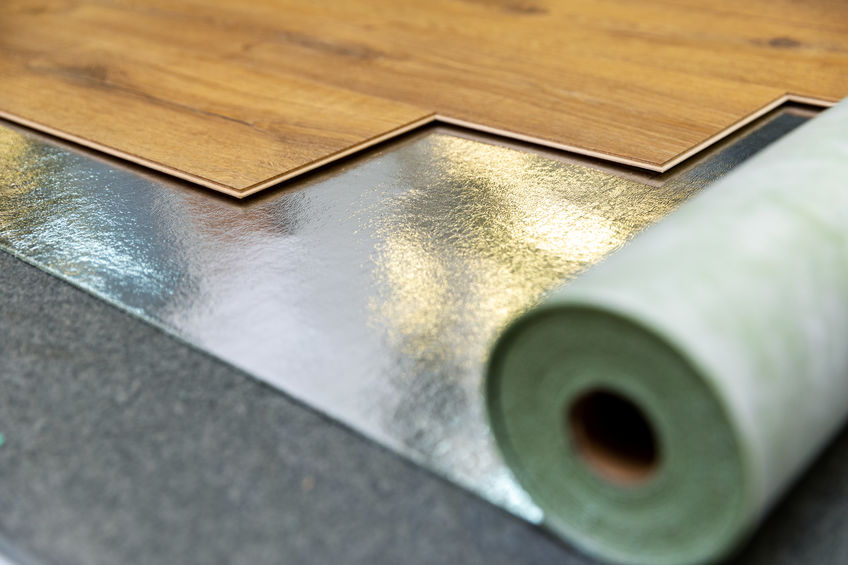Imagine yourself walking barefoot across your new laminate floor. It’s beautiful, stylish, and a perfect addition to your home. But there’s a slight problem – it feels uncomfortably hard underfoot, like you’re walking on concrete. What went wrong? You might have missed a crucial component: underlay. This seemingly simple material can make a world of difference, creating a more comfortable, quieter, and longer-lasting floor.

Image: www.alibaba.com
Let’s unpack the world of laminate flooring underlay. We’ll dive deep into its purpose, explore different types available, and guide you towards making the best choice for your specific needs. By the end of this journey, you’ll understand whether or not you really need underlay, and if so, which kind is best for your situation.
Unveiling the Secrets of Underlay
What is Laminate Flooring Underlay?
Laminate flooring underlay is a thin, flexible material placed between your subfloor and your laminate flooring. It’s not just a decorative element; it plays a vital role in enhancing the performance and longevity of your floor.
Think of it as a hidden hero working behind the scenes to ensure a smooth and satisfying flooring experience.
Why Do You Need Laminate Flooring Underlay?
Underlay isn’t just an extra cost – it’s an investment in the well-being of your laminate floor. Here are the key reasons why underlay is essential:
- Comfort: Standing or walking on bare laminate flooring can feel hard and unforgiving. Underlay acts as a cushion, offering a softer, more comfortable experience for your feet and joints. It particularly comes in handy for homes with young children or senior citizens who may be more sensitive to hard surfaces.
- Noise Reduction: Underlay significantly reduces noise transmission, both from your floor to the rooms below and from the outside world to your living space. Sound dampening is especially important for apartment dwellers who want to maintain a harmonious relationship with their neighbours. It’s also a boon for those who enjoy a quiet environment at home.
- Insulation: Some underlay materials are designed to provide additional insulation, helping keep your home warmer in winter and cooler in summer. This is particularly beneficial in colder climates or for rooms with a low level of insulation.
- Moisture Barrier: Underlay can act as a moisture barrier, protecting your laminate flooring from moisture that may seep through the subfloor. This is essential for homes with basements or crawl spaces that are susceptible to moisture issues. It also ensures the longevity of your flooring by preventing warping, swelling, and mold growth.
- Subfloor Imperfections: Even the most perfectly laid subfloor can have minor imperfections. Underlay helps to smooth out these inconsistencies, providing an even surface for your laminate flooring. This ultimately leads to a more stable, secure, and aesthetically pleasing installation.

Image: phenergandm.com
The Many Faces of Underlay
Underlay materials come in various forms, each with its unique properties and benefits:
Foam Underlay: This is the most common and affordable type of underlay. It provides good cushioning, sound absorption, and moisture resistance.
Cork Underlay: Cork is a natural, sustainable material that offers excellent sound absorption and insulation. It’s particularly good for homes seeking an eco-friendly solution.
Rubber Underlay: Rubber underlay is known for its exceptional sound dampening qualities, making it ideal for multi-level homes or areas where noise is a concern.
Composite Underlay: This type combines features of different materials, often mixing foam with a layer of moisture barrier. Composite underlays deliver a well-rounded performance package, offering cushioning, sound absorption, and moisture protection.
How to Choose the Right Underlay for Your Laminate Floor
Selecting the ideal underlay needs careful consideration. Take these factors into account:
- Your budget: Underlays range in price, so determine a budget that fits your financial situation.
- Your flooring needs: Are you seeking comfort, noise reduction, insulation, or moisture protection? Consider your priorities and pick a material that addresses them.
- The subfloor condition: If your subfloor has significant imperfections, a thicker underlay might be needed.
Top Tips for Installing Laminate Flooring Underlay
- Measure: Accurately measure your room and purchase enough underlay to cover the entire flooring area. Add extra to allow for waste during cutting and installation.
- Ventilation: Ensure proper ventilation in the room before installation, allowing the underlay to air out before laying the laminate flooring.
- Moisture Barrier: If your subfloor is prone to moisture, choose moisture-resistant underlay and lay a vapor barrier (such as polythene) below it to prevent water damage.
- Laying: Follow the manufacturer’s instructions for laying your chosen underlay. In most cases, it’s recommended to lay the underlay in a continuous sheet, ensuring there are no gaps or overlaps.
Do You Need Underlay For Laminate Flooring
Empowering You to Make the Right Choice
The decision to purchase underlay for your laminate flooring is a wise one. It’s not just an optional extra; it’s an investment in the longevity, comfort, and overall performance of your floor. It safeguards your flooring, minimizes noise, and creates a more enjoyable space for you and your family. Explore the diverse range of underlay options available, choose the one that meets your needs and budget, and reap the rewards of a truly delightful flooring experience.
Now that you understand the importance and diversity of underlay, go on and choose the one that’s perfect for you. Feel the difference it makes in comfort, appreciate the quietude, and enjoy the enhanced durability of your beautifully installed laminate floor!






